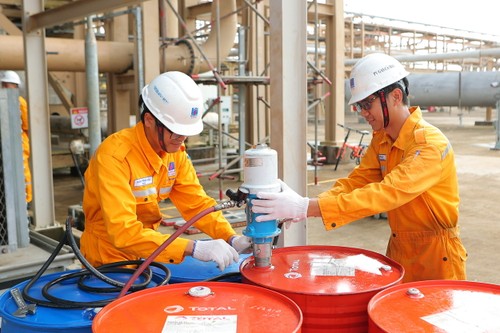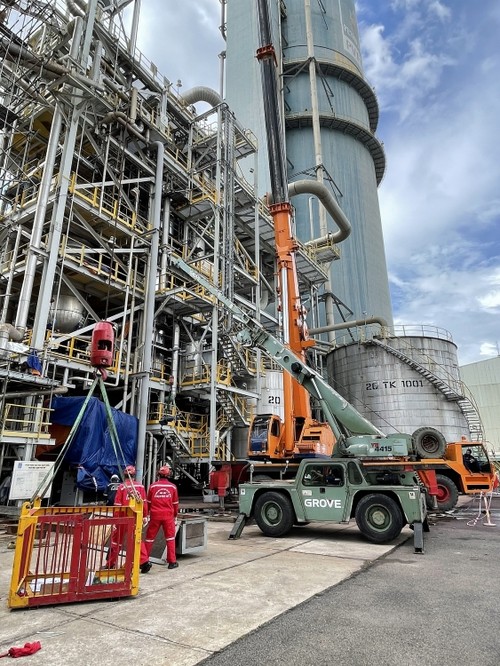 Ca Mau Gas Company maintains the system in 2023 (Photo: pvgas.com.vn) Ca Mau Gas Company maintains the system in 2023 (Photo: pvgas.com.vn) |
The exploitation of gas fields is planned annually by the owners (with the participation of Petrovietnam and other parties) basing on exploitation ability, safety of mining operations, purchasing commitment, and demand of customers under long-term contracts.
In recent decades, the use of natural gas to generate power, produce fertilizer, and in other industrial production has been popular in Vietnam. Natural gas is a clean energy source, which helps manufacturers save costs and reduce environmental pollution.
This is a specific type of commodity and is exploited mostly from gas fields on Vietnam’s continental shelf. After being exploited, natural gas is transported by gas pipelines to shore and distributed to customers, which are power plants, fertilizer plants, and industrial customers, that concentrate mainly in the Southeast and Southwest regions.
In order to effectively develop and exploit gas fields, it requires synchronous development of gas pipelines and consumer system.
The exploitation of gas fields is planned annually by the owners (with the participation of Petrovietnam and foreign partners) basing on exploitation ability, safety of drilling activities, and commitments to buy and demand for gas from customers under long-term contracts.
The unplanned increase in demand for natural gas by power plants and fertilizer plants every year will be considered very carefully by field owners. Due to technical limitations in exploitation activities at offshore natural gas fields, especially natural gas reserve currently in decline, it’s necessary to stabilize exploitation to ensure safe operation and exploitation of underground resources.
 Maintenance work at Phu My Fertilizer Plant (Photo: petrovietnam.petrotimes.vn) Maintenance work at Phu My Fertilizer Plant (Photo: petrovietnam.petrotimes.vn) |
The power supply plan and operation of the national power system in 2023 was issued by the Ministry of Industry and Trade in Decision No. 2976/QD-BCT dated December 30, 2022, in which electricity output produced from natural gas accounts for about 10.4% of the total national output. According to this plan, Petrovietnam and other parties in the gas system in the Southeast and Southwest regions will supply about 5.6 billion m3 of gas (the Southeast region about 4.3 billion m3, and the Southwest region about 1.3 billion m3 for electricity production in 2023.
Because the demand for natural gas for electricity production in the first quarter of 2023 was very low, by the end of April 2023 the amount of gas mobilized for power plants only reached 96% of the plan assigned by the Ministry of Industry and Trade.
Facing increasing demand of the power system, Petrovietnam and parties in the gas system have coordinated to implement technical solutions to maximize the amount of natural gas exploited domestically. At the same time, Petrovietnam also has agreed with Petronas to buy all gas exploited from the PM3-CAA field cluster with Malaysia to increase the amount of gas supply for domestic electricity production.
It is expected that in 2023 Petrovietnam will provide about 5.87 billion m3 of natural gas for electricity production (including 4.55 billion m3 in the Southeast region and 1.32 billion m3 in the Southeast region), which is estimated to exceed 104.8% compared to the Ministry of Industry and Trade’s plan.
It is worth mentioning that up to now, the highest mobilized capacity of gas power plants only accounts for about 12% of the total capacity of mobilized power sources. In order to complete the power supply plan approved by the Ministry of Industry and Trade, the manager of power generation, transportation, allocation, and distribution system should mobilize the participation of many other power generation sources besides gas power (coal power, hydropower, renewable energy).
For fertilizer plants in the Southeast and Southwest regions which use natural gas as input materials for production (having no alternative materials) since 2006 until now, gas consumption demand has been remained stable at about 1.1 billion m3 of gas per year for the two Phu My Fertilizer and Ca Mau Fertilizer plants, contributing to national food security.
Making plans for gas use as well as maintenance of fertilizer plants to optimize gas supply have been jointly carried out by related parties in compliance with strict regulations of gas purchase contracts with long-term commitments.
The owners of the Phu My Fertilizer and Ca Mau Fertilizer plants are joint stock companies, so activities affecting production and business efficiency, and planned long-term gas supply suspension/reduction, must all be approved by the General Meeting of Shareholders of these companies before implementation. The unplanned suspension/reduction of gas supply to Phu My Fertilizer and Ca Mau Fertilizer plants will have great impacts on their production and business activities, leading to many consequences for related parties, and will depend on the approval, goodwill, and cooperation of shareholders of fertilizer plants. The suspension/reduction of natural gas for fertilizer plants does not help much (nearly 1%) for ensuring the operation of the national power system.
The demand of natural gas for electricity production is essential, especially during the dry months from April to June every year. However, in order to maintain long-term natural gas supply for electricity production and ensure national energy security, it is expected that functional agencies consider and promulgate a mechanism to develop a stable, safe power base for the whole system, regulations on power system operation which are consistent with the natural gas purchase commitment mechanism and reasonable electricity price policy to help investors of power plants feel secure in signing long-term gas purchase contracts, especially when cheap domestic natural gas sources are exhausted and the price of imported LNG is increasing.